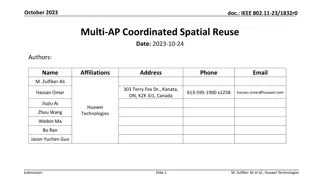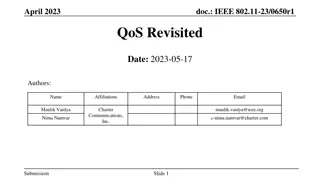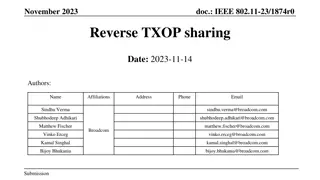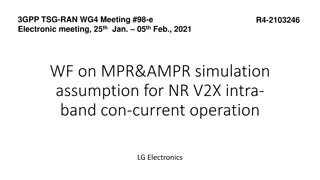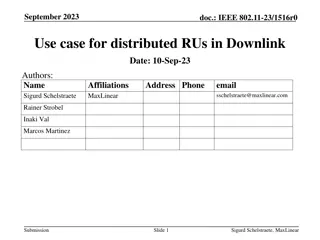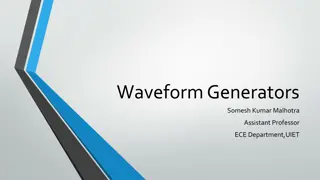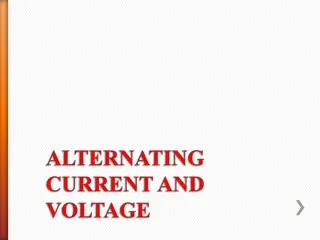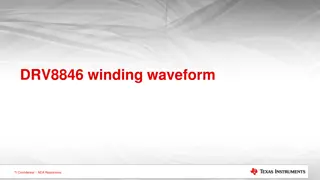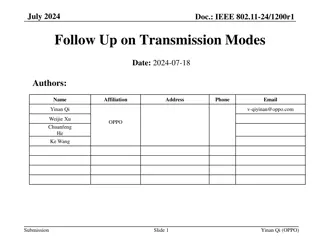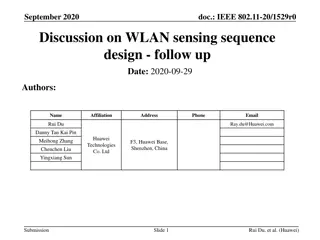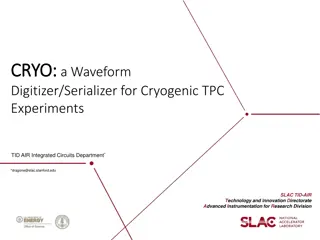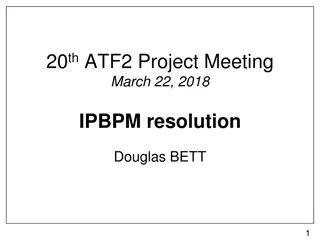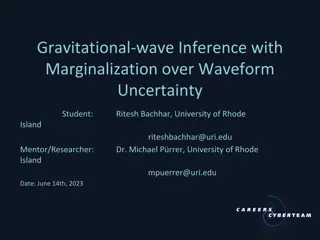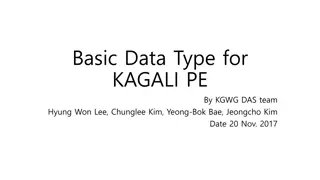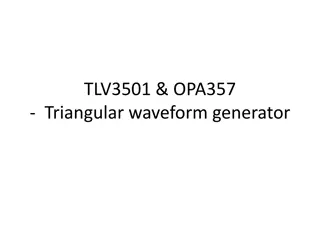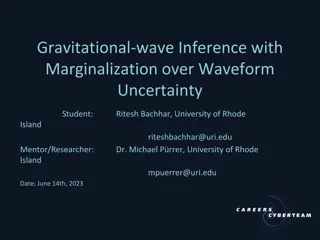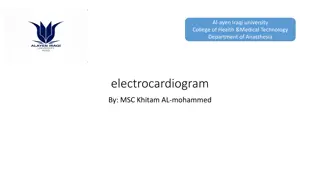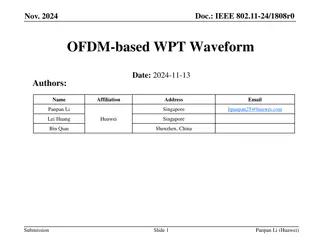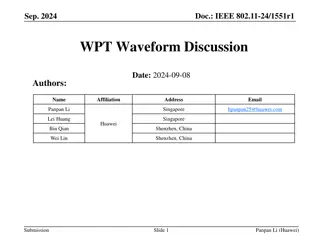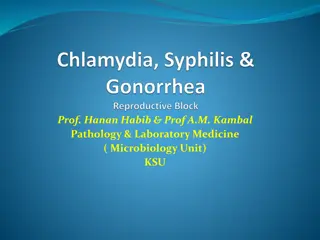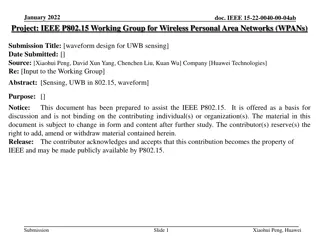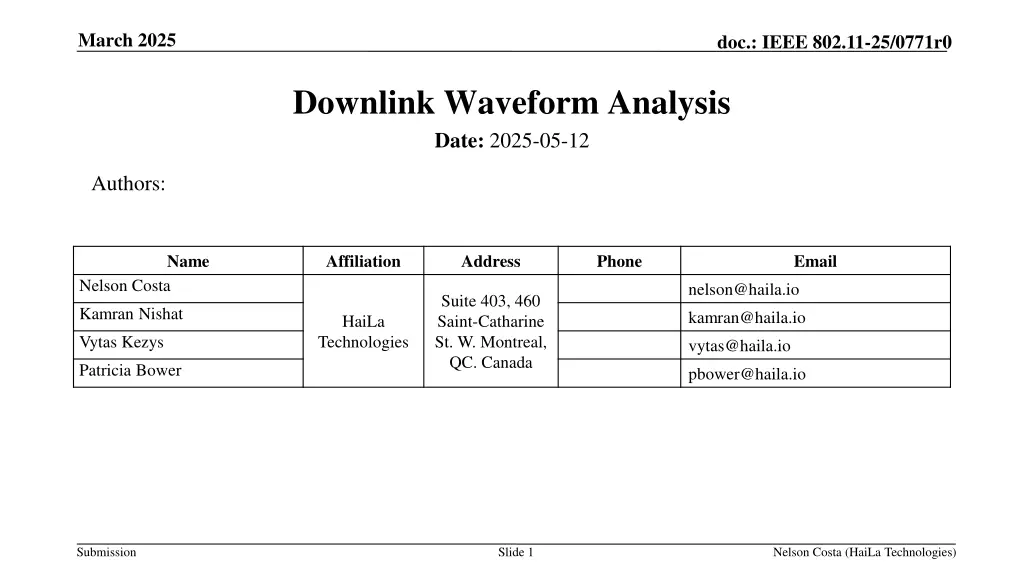
IEEE 802.11-25/0771r0 Downlink Waveform Analysis
Explore the analysis of four different downlink waveforms proposed by IEEE 802.11-25/0771r0 group. Compare advantages, disadvantages, and metrics. Discuss the construction of carrier waveform for AMP Downlink PPDU. Review OFDM-based waveforms, spreading sequences, and L-LTF training sequences. Consider regulatory limits in waveform design.
Download Presentation

Please find below an Image/Link to download the presentation.
The content on the website is provided AS IS for your information and personal use only. It may not be sold, licensed, or shared on other websites without obtaining consent from the author. If you encounter any issues during the download, it is possible that the publisher has removed the file from their server.
You are allowed to download the files provided on this website for personal or commercial use, subject to the condition that they are used lawfully. All files are the property of their respective owners.
The content on the website is provided AS IS for your information and personal use only. It may not be sold, licensed, or shared on other websites without obtaining consent from the author.
E N D
Presentation Transcript
March 2025 doc.: IEEE 802.11-25/0771r0 Downlink Waveform Analysis Date: 2025-05-12 Authors: Name Affiliation Address Phone Email Nelson Costa nelson@haila.io Suite 403, 460 Saint-Catharine St. W. Montreal, QC. Canada Kamran Nishat kamran@haila.io HaiLa Vytas Kezys Technologies vytas@haila.io Patricia Bower pbower@haila.io Submission Slide 1 Nelson Costa (HaiLa Technologies)
March 2025 doc.: IEEE 802.11-25/0771r0 Abstract In the following, we review four different downlink waveforms proposed by the group. We analyze each waveform using a common framework, and compare the advantages and disadvantages of each waveform. We propose a common set of metrics and properties by which we can compare downlink waveforms. Submission Slide 2 Nelson Costa (HaiLa Technologies)
March 2025 doc.: IEEE 802.11-25/0771r0 Background In March, the group agreed to add a broad framework for downlink sequences into the SFD. The carrier waveform for AMP Downlink PPDU is constructed by repeating one predefined base waveform of TBD micro-second, and additional pseudo-random phase is applied to each base waveform The base waveform definition is TBD. Within this framework, in the following we consider the four proposed base waveforms. Submission Slide 3 Nelson Costa (HaiLa Technologies)
March 2025 doc.: IEEE 802.11-25/0771r0 Background In [1], the authors present a 4 s OFDM-based waveform. For the 250 kbps and 1 Mbps DL rates, the Man-OOK symbols slice the OFDM symbols. The base waveform is 64 + 16 samples (OFDM symbol + CP) at 20 MHz. Submission Slide 4 Nelson Costa (HaiLa Technologies)
March 2025 doc.: IEEE 802.11-25/0771r0 Background In [2,3], the authors each present a different 1 s spreading sequence. For the 250 kbps rate, there are two 1 s spreading sequences per 2 s Man-OOK chip. For the 1 Mbps rate, there are two 0.5 s Man-OOK chips per spreading sequence. Submission Slide 5 Nelson Costa (HaiLa Technologies)
March 2025 doc.: IEEE 802.11-25/0771r0 Background The group has also discussed using the L-LTF training sequence. The version used here is an 8 s consisting of two repeated 3.2 s OFDM symbols C, and a 1.6 s cyclic prefix CP. The CP is the second half of the OFDM symbol. The random variable RV is multiplied by the entire 8 s symbol. Submission Slide 6 Nelson Costa (HaiLa Technologies)
March 2025 doc.: IEEE 802.11-25/0771r0 Considerations: Regulatory Limits (SFD) The base waveform cannot be <10 MHz (3 dB bandwidth). ETSI regulations put limits on total EIRP and Power Spectral Density. ETSI EN 300 328 V2.2.2 states the following. Total EIRP of 20 dBm. Maximum Power Spectral Density is 10 dBm per MHz. PSD is measured using Max Hold (peak hold). PSD is measured across entire 2.4 GHz band. Here, for comparison, we present spectral density estimates for both the averaged and Max Hold cases. Submission Slide 7 Nelson Costa (HaiLa Technologies)
March 2025 doc.: IEEE 802.11-25/0771r0 Considerations: PAPR Peak-to-Average power ratio (PAPR) is another metric that affects PA efficiency. In OFDM-related contributions [3-4], the authors estimate PAPR (or they estimate a proxy metric). It s not clear if the PA in an OOK transmitter would have to deal with the PAPR for the entire OOK sequence, or just the ON symbols. Here, for comparison, we present a conventional PAPR estimate for the case where 1) the PA deals with the entire Man-OOK sequence, and 2) the PA only deals with the ON symbol. We also consider the effect of filtering on PAPR. Filtering the transmit waveform generally increases PAPR. Submission Slide 8 Nelson Costa (HaiLa Technologies)
May 2025 doc.: IEEE 802.11-25/0771r0 Consideration: PSK Backscatter Modulation [5] describes how we can use PSK modulation in bistatic backscatter to increase link margin for backscatter devices. Potential 6 dB total improvement in link margin (3 dB backscatter efficiency + 3 dB receiver sensitivity) Backscatter STAs that are capable of PSK are also compatible with OOK backscatter modulation. PSK modulation on backscatter requires some coherency in the base waveform. It is possible to backscatter OFDM, however the symbol time is incompatible with the uplink rates. The spreading sequences don t work for PSK backscatter; they re not correlative. Submission Slide 9 Nelson Costa (HaiLa Technologies)
May 2025 doc.: IEEE 802.11-25/0771r0 Unmodulated Base Waveforms OFDM (11-25/0325) L-LTF DSSS (11-25/0050) DSSS (11-25/0440) PAPR (before filter): 4.1 dB PAPR (after filter): 4.1 dB PAPR (before filter): 3.2 dB PAPR (after filter): 3.4 dB PAPR (before filter): 0 dB PAPR (after filter): 2.7 dB PAPR (before filter): 0 dB PAPR (after filter): 2.5 dB Max 1 MHz bin power: 9.1 dBm Max 1 MHz bin power: 8.1 dBm Max 1 MHz bin power: 11.6 dBm Max 1 MHz bin power: 15.4 dBm As per ETSI procedure, each waveform is normalized to 20 dBm before evaluating the 1 MHz PSD limit. PAPR is computed before and after filtering. Submission Slide 10 Nelson Costa (HaiLa Technologies)
May 2025 doc.: IEEE 802.11-25/0771r0 Base Waveforms Modulated with 250 kbps Man-OOK OFDM (11-25/0325) L-LTF DSSS (11-25/0050) DSSS (11-25/0440) PAPR (before filter): 7.1 dB PAPR (filtered, full sequence): 7.2 dB PAPR (filtered, ON symbol): 5.9 dB PAPR (before filter): 6.2 dB PAPR (filtered, full sequence): 6.4 dB PAPR (filtered, ON symbol): 5.2 dB PAPR (before filter): 3.0 dB PAPR (filtered, full sequence): 5.7 dB PAPR (filtered, ON symbol): 4.5 dB PAPR (before filter): 3.0 dB PAPR (filtered, full sequence): 5.5 dB PAPR (filtered, ON symbol): 4.3 dB Max 1 MHz bin power: 9.7 dBm Max 1 MHz bin power: 8.0 dBm Max 1 MHz bin power: 11.8 dBm Max 1 MHz bin power: 15.4 dBm Submission Slide 11 Nelson Costa (HaiLa Technologies)
May 2025 doc.: IEEE 802.11-25/0771r0 Base Waveforms Modulated with 1 Mbps Man-OOK OFDM (11-25/0325) L-LTF DSSS (11-25/0050) DSSS (11-25/0440) PAPR (before filter): 7.1 dB PAPR (filtered, full sequence): 7.2 dB PAPR (filtered, ON symbol): 6.1 dB PAPR (before filter): 6.2 dB PAPR (filtered, full sequence): 6.5 dB PAPR (filtered, ON symbol): 5.3 dB PAPR (before filter): 3.0 dB PAPR (filtered, full sequence): 5.9 dB PAPR (filtered, ON symbol): 4.9 dB PAPR (before filter): 3.0 dB PAPR (filtered, full sequence): 5.4 dB PAPR (filtered, ON symbol): 4.4 dB Max 1 MHz bin power: 9.7 dBm Max 1 MHz bin power: 8.0 dBm Max 1 MHz bin power: 12.5 dBm Max 1 MHz bin power: 14.7 dBm Submission Slide 12 Nelson Costa (HaiLa Technologies)
May 2025 doc.: IEEE 802.11-25/0771r0 Downlink Base Waveforms: Summary Submission Slide 13 Nelson Costa (HaiLa Technologies)
March 2025 doc.: IEEE 802.11-25/0771r0 Conclusion In this presentation, we reviewed four different proposed base waveforms. These waveforms are intended to be used to carry OOK, Man-OOK data in the DL for AMP STAs. They would also be used as the backscatter excitation waveform. The OFDM waveforms exhibit good spectral properties, but higher PAPR. The DSSS waveforms all exceed the ETSI 1 MHz PSD limit. The DSSS waveforms generally have poor spectral properties, and require more filtering to meet the spectral mask. More filtering increases PAPR. None of the proposed waveforms are suitable for PSK backscatter. However, with small modifications, we believe they can be. PSK backscatter provides up to 6 dB more link margin in bistatic backscatter. Submission Slide 14 Nelson Costa (HaiLa Technologies)
March 2025 doc.: IEEE 802.11-25/0771r0 References [1] Li et al., AMP DL Wideband OOK Generation, 11-25/0050, January 2025. [2] Wang et al., Follow-up on AMP DL OOK generation, 11-25/0440, March 2025. [3] Shellhammer et al., AMP Downlink Bandwidth Control using OFDM Spreading Waveform, 11- 25/0325, March 2025. [4] Cao et al., AMP Downlink and Backscattering Carrier Waveform, 11-25/0305, March 2025. [5] Costa et al., PSK Modulation for Long-Range Backscatter, 11-25/0266, March 2025. Submission Slide 15 Nelson Costa (HaiLa Technologies)

